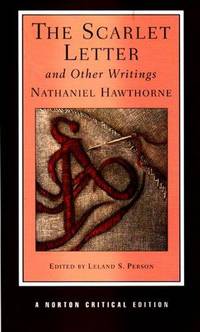He is seen as a key figure in the development of American literature.
Nathaniel Hawthorne was a famous author who was born in Salem, Massachusetts, where his birthplace is now a house museum, and died in Plymouth, New Hampshire. Hawthorne's father was a sea captain and descendant of John Hathorne, one of the judges who oversaw the Salem Witch Trials. (The author added the "w" to his surname in his early twenties.) Hawthorne's father died at sea in 1808 of yellow fever when Hawthorne was only four years old, and Nathaniel was raised secluded from the world by his mother.
Hawthorne attended Bowdoin College in Maine from 1821–1824, befriending classmates Henry Wadsworth Longfellow and future president Franklin Pierce. Until the publication of his
Twice-Told Tales in 1837, Hawthorne wrote in the comparative obscurity of what he called his "owl's nest" in the family home. As he looked back on this period of his life, he wrote: "I have not lived, but only dreamed about living" [letter to Longfellow, June 4, 1837]. And yet it was this period of brooding and writing that had formed, as Malcolm Cowley was to describe it,"the central fact in Hawthorne's career," his "term of apprenticeship" that would eventually result in the "richly meditated fiction."
Hawthorne was hired in 1839 as a weigher and gauger at the Boston Custom House. He had become engaged in the previous year to the illustrator and transcendentalist Sophia Peabody. Seeking a possible home for himself and Sophia, he joined the transcendentalist utopian community at Brook Farm in 1841; later that year, however, he left when he became dissatisfied with the experiment. (His Brook Farm adventure would prove an inspiration for his novel,
The Blithedale Romance.) He married Sophia in 1842; they moved to
The Old Manse in Concord, Massachusetts, where they lived for three years. Hawthorne and his wife then moved to The Wayside, previously a home of the Alcotts. Their neighbors in Concord included Ralph Waldo Emerson and Henry David Thoreau.
Like Hawthorne, Sophia was a reclusive person. She was, in fact, bedridden with headaches until her sister introduced her to Hawthorne, after which her headaches seem to have abated. The Hawthornes enjoyed a long marriage, and Sophia was greatly enamored of her husband's work. In one of her journals, she writes: "I am always so dazzled and bewildered with the richness, the depth, the... jewels of beauty in his productions that I am always looking forward to a second reading where I can ponder and muse and fully take in the miraculous wealth of thoughts" [Jan 14th 1851, Journal of Sophia Hawthorne. Berg Collection NY Public Library].
In 1846 Hawthorne was appointed surveyor (determining the quantity and value of imported goods) at the Salem Custom House. Like his earlier appointment to the custom house in Boston, this employment was vulnerable to the politics of the spoils system. When Hawthorne later wrote
The Scarlet Letter, he included a long introductory essay depicting his time at the Salem Custom House. He lost this job due to the change of administration in Washington after the presidential election of 1848. In 1852 he wrote the campaign biography of his old friend, Franklin Pierce. With Pierce's election as president, Hawthorne was rewarded in 1853 with the position of United States consul in Liverpool. In 1857 he resigned from this post and did some traveling in France and Italy. He and his family returned to The Wayside in 1860. Failing health (which biographer Edward Miller speculates was stomach cancer) began to prevent him from completing new writings. Hawthorne died in his sleep on May 19, 1864 in Plymouth, N.H. while on a tour of the White Mountains with Pierce.
Nathaniel and Sophia Hawthorne had three children: Una, Julian, and Rose. Una suffered from mental illness and died young. Julian moved out west, served a jail term for embezzlement, and wrote a book about his father. Rose married George Parsons Lathrop, converted to Roman Catholicism and took her vows as a Dominican nun. She founded a religious orderto care for victims of incurable cancer.
Hawthorne is best-known today for his many short stories (he called them "tales") and his four major romances of 1850–60:
Fanshawe, was published anonymously in 1828.)
Before publishing his first collection of tales in 1837, Hawthorne wrote scores of short stories and sketches, publishing them anonymously or pseudonymously in periodicals such as The New-England Magazine and The United States Democratic Review. (The editor of the Democratic Review, John L. O'Sullivan, was a close friend of Hawthorne's.) Only after collecting a number of his short stories into the two-volume Twice-Told Tales in 1837 did Hawthorne begin to attach his name to his
Works.
Much of Hawthorne's work is set in colonial New England, and many of his short stories have been read as moral allegories influenced by his Puritan background. "Tanglewood Tales (1853) was a re-writing some of the most famous of the ancient Greek myths in a volume for children, and from which was named Tanglewood estate and music venue.
Recent criticism has focused on Hawthorne's narrative voice, treating it as a self-conscious rhetorical construction, not to be conflated with Hawthorne's own voice. Such an approach complicates the long-dominant tradition of regarding Hawthorne as a gloomy, guilt-ridden moralist.
Hawthorne enjoyed a brief but intense friendship with American novelist Herman Melville beginning on August 5, 1850, when the two authors met at a picnic hosted by a mutual friend. Melville had just read Hawthorne's short story collection Hawthorne and His Mosses." Melville's letters to Hawthorne provide insight into the composition of Moby-Dick, which Melville dedicated to Hawthorne, 'in appreciation for his genius.' Hawthorne's letters to Melville did not survive.


































